Leadership in Education: Transformational Leadership and Challenges
VerifiedAdded on 2022/10/10
|13
|3666
|7
Essay
AI Summary
This essay delves into the multifaceted concept of leadership within the realm of education. It begins by defining leadership and contrasting it with management, highlighting the significance of leadership qualities and the application of different leadership models. The essay then focuses on transformational leadership, examining its key practices and benefits, using examples like Howard Schultz's leadership at Starbucks. The second part of the essay addresses a critical educational problem: sexual harassment faced by female teachers in universities. It analyzes the causes of this issue, proposes potential solutions, and emphasizes the importance of ethical considerations and training. The essay concludes by advocating for the implementation of transformational leadership styles to foster a supportive and effective learning environment for both educators and students, and promoting ethical leadership practices.
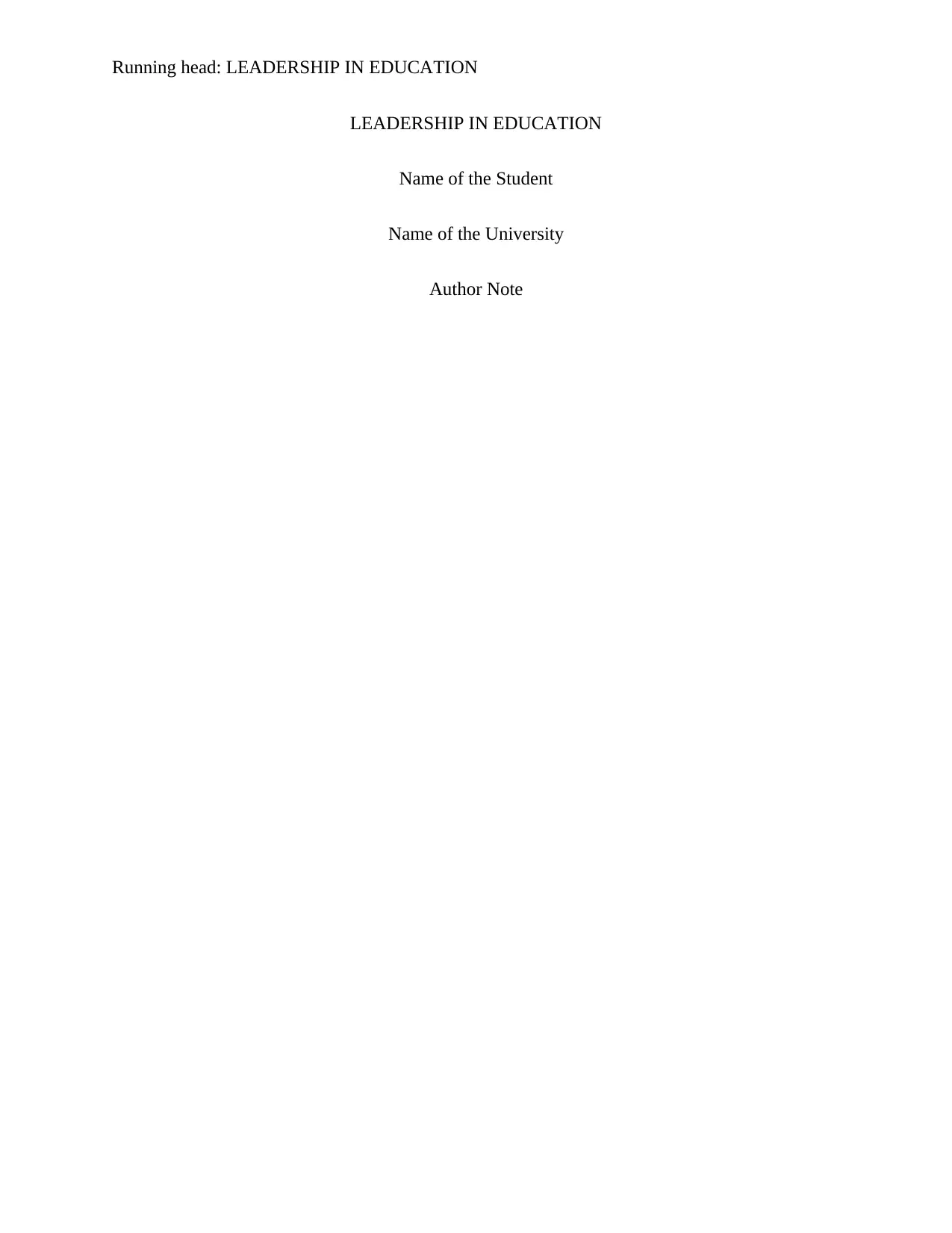
Running head: LEADERSHIP IN EDUCATION
LEADERSHIP IN EDUCATION
Name of the Student
Name of the University
Author Note
LEADERSHIP IN EDUCATION
Name of the Student
Name of the University
Author Note
Paraphrase This Document
Need a fresh take? Get an instant paraphrase of this document with our AI Paraphraser
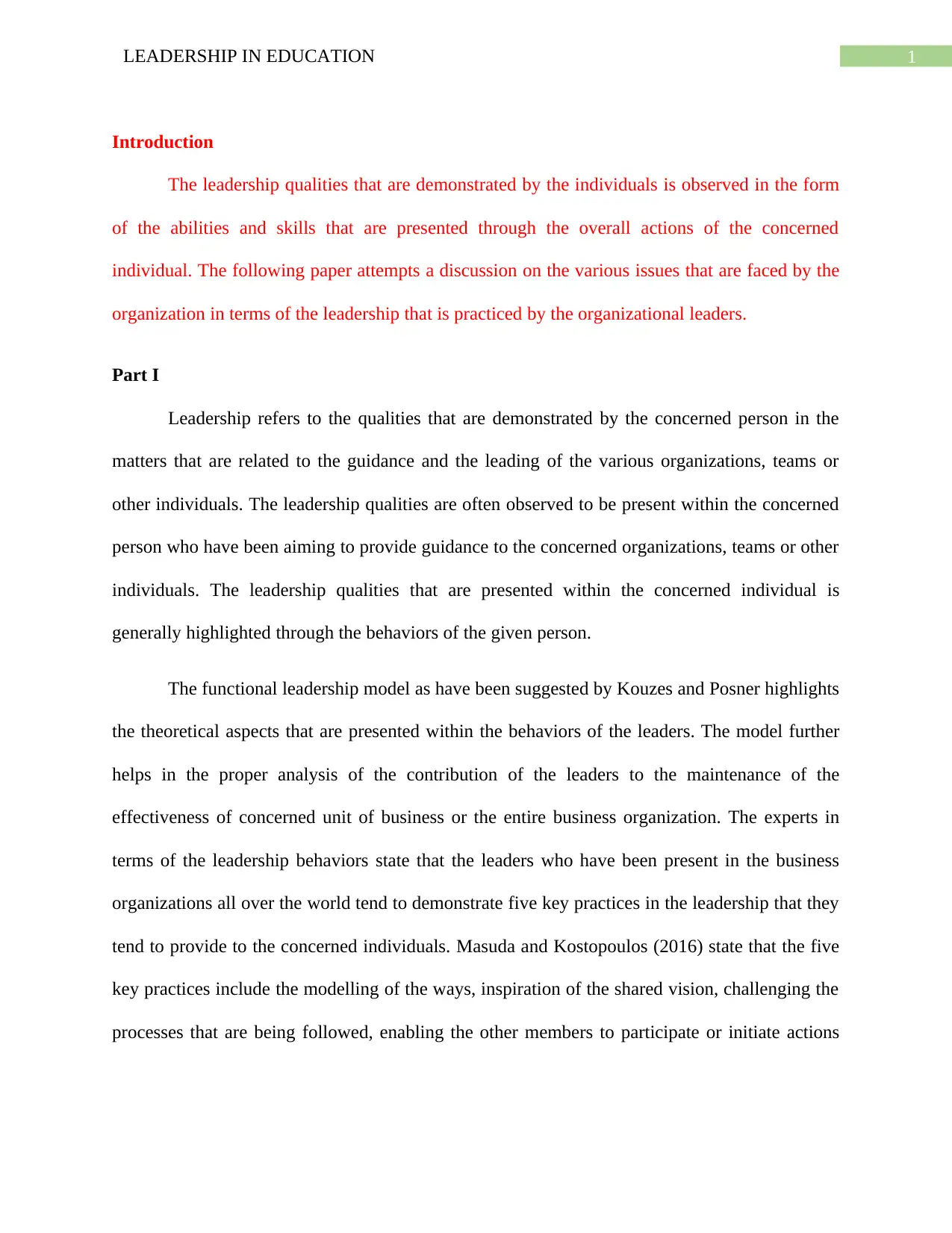
1LEADERSHIP IN EDUCATION
Introduction
The leadership qualities that are demonstrated by the individuals is observed in the form
of the abilities and skills that are presented through the overall actions of the concerned
individual. The following paper attempts a discussion on the various issues that are faced by the
organization in terms of the leadership that is practiced by the organizational leaders.
Part I
Leadership refers to the qualities that are demonstrated by the concerned person in the
matters that are related to the guidance and the leading of the various organizations, teams or
other individuals. The leadership qualities are often observed to be present within the concerned
person who have been aiming to provide guidance to the concerned organizations, teams or other
individuals. The leadership qualities that are presented within the concerned individual is
generally highlighted through the behaviors of the given person.
The functional leadership model as have been suggested by Kouzes and Posner highlights
the theoretical aspects that are presented within the behaviors of the leaders. The model further
helps in the proper analysis of the contribution of the leaders to the maintenance of the
effectiveness of concerned unit of business or the entire business organization. The experts in
terms of the leadership behaviors state that the leaders who have been present in the business
organizations all over the world tend to demonstrate five key practices in the leadership that they
tend to provide to the concerned individuals. Masuda and Kostopoulos (2016) state that the five
key practices include the modelling of the ways, inspiration of the shared vision, challenging the
processes that are being followed, enabling the other members to participate or initiate actions
Introduction
The leadership qualities that are demonstrated by the individuals is observed in the form
of the abilities and skills that are presented through the overall actions of the concerned
individual. The following paper attempts a discussion on the various issues that are faced by the
organization in terms of the leadership that is practiced by the organizational leaders.
Part I
Leadership refers to the qualities that are demonstrated by the concerned person in the
matters that are related to the guidance and the leading of the various organizations, teams or
other individuals. The leadership qualities are often observed to be present within the concerned
person who have been aiming to provide guidance to the concerned organizations, teams or other
individuals. The leadership qualities that are presented within the concerned individual is
generally highlighted through the behaviors of the given person.
The functional leadership model as have been suggested by Kouzes and Posner highlights
the theoretical aspects that are presented within the behaviors of the leaders. The model further
helps in the proper analysis of the contribution of the leaders to the maintenance of the
effectiveness of concerned unit of business or the entire business organization. The experts in
terms of the leadership behaviors state that the leaders who have been present in the business
organizations all over the world tend to demonstrate five key practices in the leadership that they
tend to provide to the concerned individuals. Masuda and Kostopoulos (2016) state that the five
key practices include the modelling of the ways, inspiration of the shared vision, challenging the
processes that are being followed, enabling the other members to participate or initiate actions
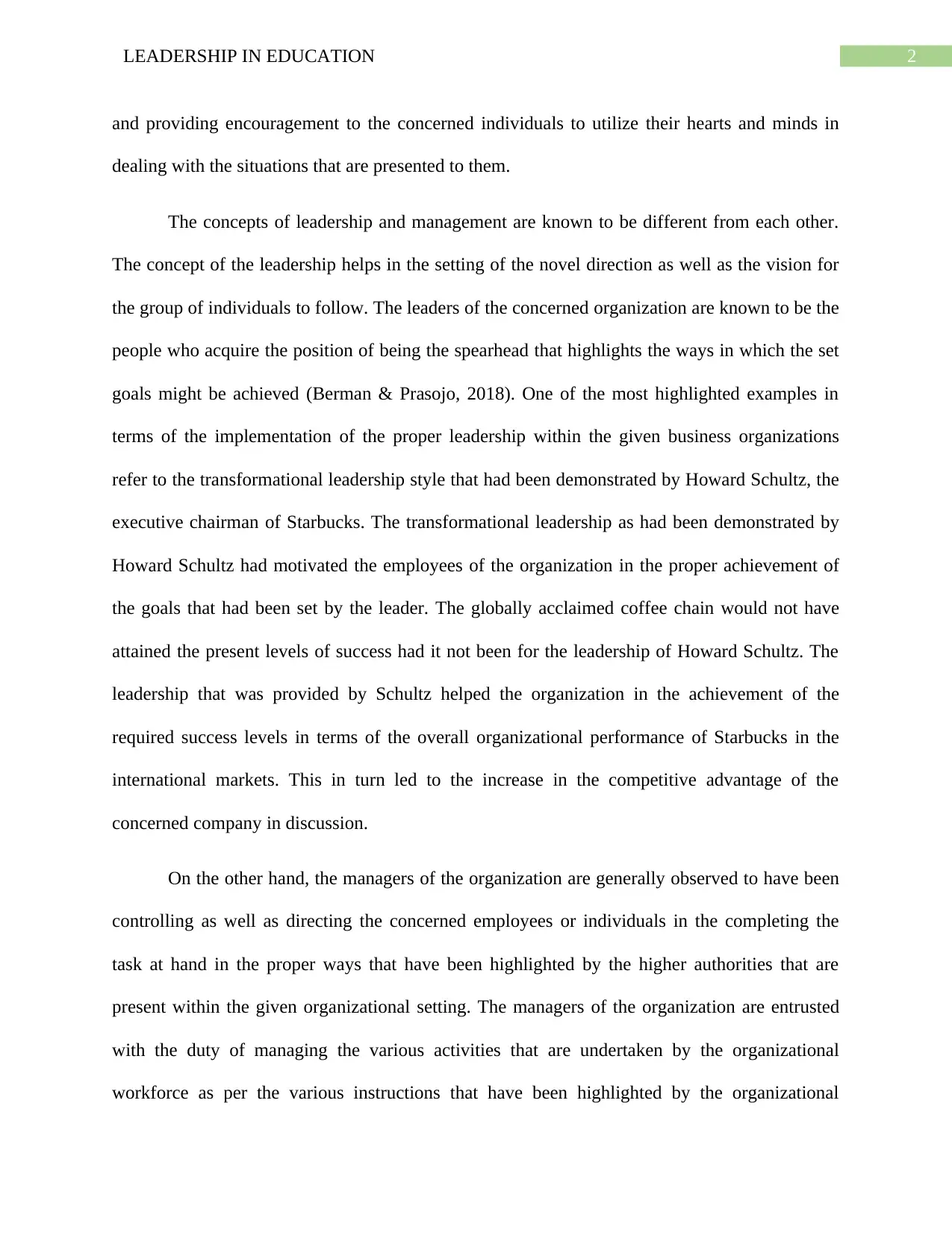
2LEADERSHIP IN EDUCATION
and providing encouragement to the concerned individuals to utilize their hearts and minds in
dealing with the situations that are presented to them.
The concepts of leadership and management are known to be different from each other.
The concept of the leadership helps in the setting of the novel direction as well as the vision for
the group of individuals to follow. The leaders of the concerned organization are known to be the
people who acquire the position of being the spearhead that highlights the ways in which the set
goals might be achieved (Berman & Prasojo, 2018). One of the most highlighted examples in
terms of the implementation of the proper leadership within the given business organizations
refer to the transformational leadership style that had been demonstrated by Howard Schultz, the
executive chairman of Starbucks. The transformational leadership as had been demonstrated by
Howard Schultz had motivated the employees of the organization in the proper achievement of
the goals that had been set by the leader. The globally acclaimed coffee chain would not have
attained the present levels of success had it not been for the leadership of Howard Schultz. The
leadership that was provided by Schultz helped the organization in the achievement of the
required success levels in terms of the overall organizational performance of Starbucks in the
international markets. This in turn led to the increase in the competitive advantage of the
concerned company in discussion.
On the other hand, the managers of the organization are generally observed to have been
controlling as well as directing the concerned employees or individuals in the completing the
task at hand in the proper ways that have been highlighted by the higher authorities that are
present within the given organizational setting. The managers of the organization are entrusted
with the duty of managing the various activities that are undertaken by the organizational
workforce as per the various instructions that have been highlighted by the organizational
and providing encouragement to the concerned individuals to utilize their hearts and minds in
dealing with the situations that are presented to them.
The concepts of leadership and management are known to be different from each other.
The concept of the leadership helps in the setting of the novel direction as well as the vision for
the group of individuals to follow. The leaders of the concerned organization are known to be the
people who acquire the position of being the spearhead that highlights the ways in which the set
goals might be achieved (Berman & Prasojo, 2018). One of the most highlighted examples in
terms of the implementation of the proper leadership within the given business organizations
refer to the transformational leadership style that had been demonstrated by Howard Schultz, the
executive chairman of Starbucks. The transformational leadership as had been demonstrated by
Howard Schultz had motivated the employees of the organization in the proper achievement of
the goals that had been set by the leader. The globally acclaimed coffee chain would not have
attained the present levels of success had it not been for the leadership of Howard Schultz. The
leadership that was provided by Schultz helped the organization in the achievement of the
required success levels in terms of the overall organizational performance of Starbucks in the
international markets. This in turn led to the increase in the competitive advantage of the
concerned company in discussion.
On the other hand, the managers of the organization are generally observed to have been
controlling as well as directing the concerned employees or individuals in the completing the
task at hand in the proper ways that have been highlighted by the higher authorities that are
present within the given organizational setting. The managers of the organization are entrusted
with the duty of managing the various activities that are undertaken by the organizational
workforce as per the various instructions that have been highlighted by the organizational
⊘ This is a preview!⊘
Do you want full access?
Subscribe today to unlock all pages.

Trusted by 1+ million students worldwide
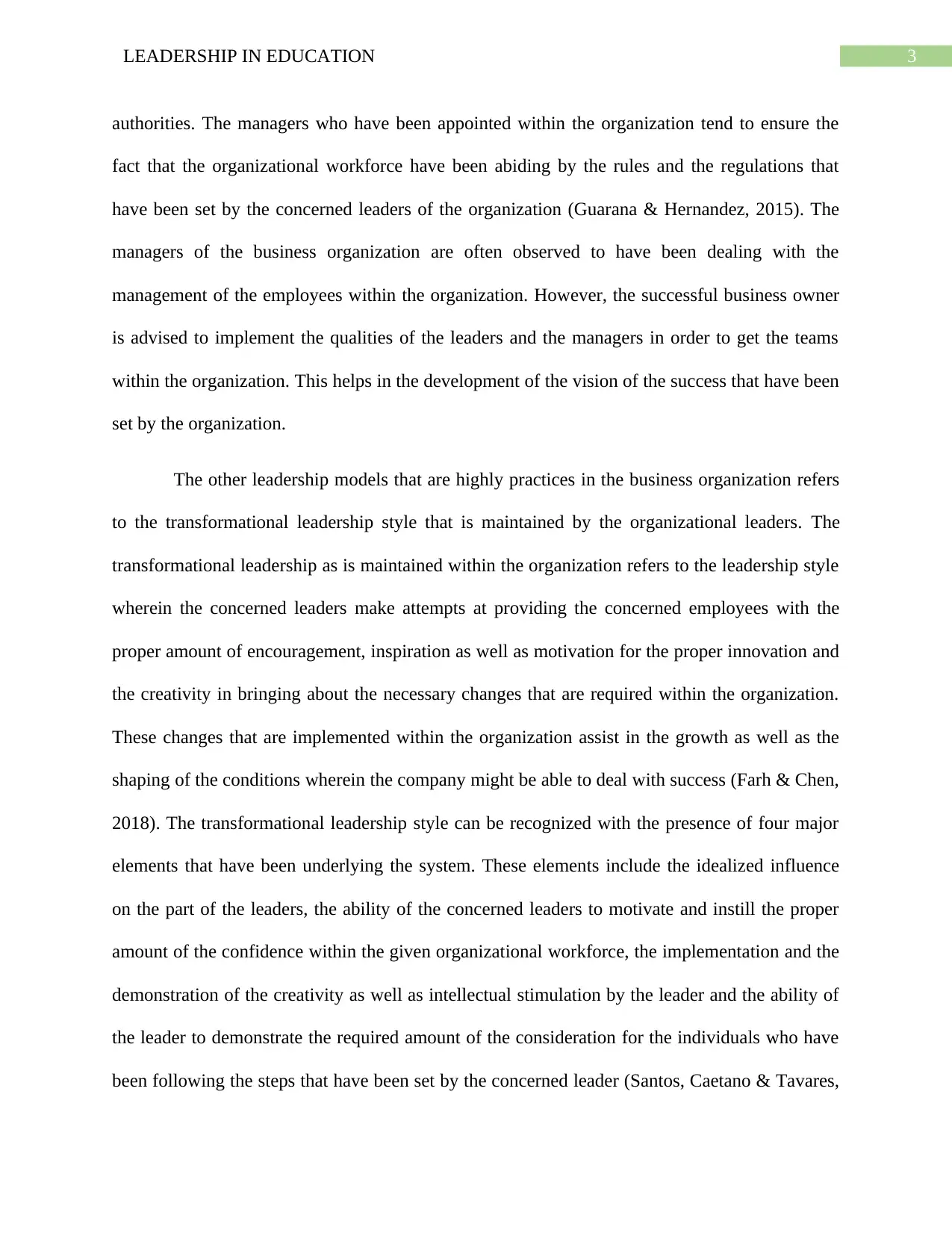
3LEADERSHIP IN EDUCATION
authorities. The managers who have been appointed within the organization tend to ensure the
fact that the organizational workforce have been abiding by the rules and the regulations that
have been set by the concerned leaders of the organization (Guarana & Hernandez, 2015). The
managers of the business organization are often observed to have been dealing with the
management of the employees within the organization. However, the successful business owner
is advised to implement the qualities of the leaders and the managers in order to get the teams
within the organization. This helps in the development of the vision of the success that have been
set by the organization.
The other leadership models that are highly practices in the business organization refers
to the transformational leadership style that is maintained by the organizational leaders. The
transformational leadership as is maintained within the organization refers to the leadership style
wherein the concerned leaders make attempts at providing the concerned employees with the
proper amount of encouragement, inspiration as well as motivation for the proper innovation and
the creativity in bringing about the necessary changes that are required within the organization.
These changes that are implemented within the organization assist in the growth as well as the
shaping of the conditions wherein the company might be able to deal with success (Farh & Chen,
2018). The transformational leadership style can be recognized with the presence of four major
elements that have been underlying the system. These elements include the idealized influence
on the part of the leaders, the ability of the concerned leaders to motivate and instill the proper
amount of the confidence within the given organizational workforce, the implementation and the
demonstration of the creativity as well as intellectual stimulation by the leader and the ability of
the leader to demonstrate the required amount of the consideration for the individuals who have
been following the steps that have been set by the concerned leader (Santos, Caetano & Tavares,
authorities. The managers who have been appointed within the organization tend to ensure the
fact that the organizational workforce have been abiding by the rules and the regulations that
have been set by the concerned leaders of the organization (Guarana & Hernandez, 2015). The
managers of the business organization are often observed to have been dealing with the
management of the employees within the organization. However, the successful business owner
is advised to implement the qualities of the leaders and the managers in order to get the teams
within the organization. This helps in the development of the vision of the success that have been
set by the organization.
The other leadership models that are highly practices in the business organization refers
to the transformational leadership style that is maintained by the organizational leaders. The
transformational leadership as is maintained within the organization refers to the leadership style
wherein the concerned leaders make attempts at providing the concerned employees with the
proper amount of encouragement, inspiration as well as motivation for the proper innovation and
the creativity in bringing about the necessary changes that are required within the organization.
These changes that are implemented within the organization assist in the growth as well as the
shaping of the conditions wherein the company might be able to deal with success (Farh & Chen,
2018). The transformational leadership style can be recognized with the presence of four major
elements that have been underlying the system. These elements include the idealized influence
on the part of the leaders, the ability of the concerned leaders to motivate and instill the proper
amount of the confidence within the given organizational workforce, the implementation and the
demonstration of the creativity as well as intellectual stimulation by the leader and the ability of
the leader to demonstrate the required amount of the consideration for the individuals who have
been following the steps that have been set by the concerned leader (Santos, Caetano & Tavares,
Paraphrase This Document
Need a fresh take? Get an instant paraphrase of this document with our AI Paraphraser

4LEADERSHIP IN EDUCATION
2015). The transformational leaders are generally observed to have been dealing with the various
activities that highlight their tendency to instill within the followers a vision as well as a mission
that would inspire the followers to develop an identity of their own.
The study on the transformational leadership had helped me into aspiring for the
development of the skills that are necessary for the development of transformational leadership.
The study on the transformational leadership style has helped me in understanding the fact that
the leaders of the organization should lead with the help of examples. The leaders should
implement the procedures and events that would lessen the gap that exist between the
organizational management and the employees of the organization. The leaders should aim at
inspiring and empathizing with the employees of the organization in order to help them
understand and adopt to the visions that are set by the organization (Boamah et al., 2018). This in
turn would help in the overall development of the tendencies of the concerned followers to make
sacrifices that would in turn greater good in the longer run.
The profession of being an educator is highly known for abiding by the professional
standards. The educators, teachers and the mentors are observed to have been dealing with the
responsibilities of educating and shaping the future of a child. The educators are required to fulfil
the roles of the leaders and the role models for the students (Eberly et al., 2017). I feel that the
transformational leadership style would be helpful in the overall development of the students and
the learners. The educators are advised to implement the transformational leadership styles that
are required for the overall development of the concerned students and the learners (Dartey-
Baah, 2015). The transformational leadership as is maintained within the organization refers to
the leadership style wherein the concerned educators make attempts at providing the concerned
students with the proper amount of encouragement, inspiration as well as motivation for the
2015). The transformational leaders are generally observed to have been dealing with the various
activities that highlight their tendency to instill within the followers a vision as well as a mission
that would inspire the followers to develop an identity of their own.
The study on the transformational leadership had helped me into aspiring for the
development of the skills that are necessary for the development of transformational leadership.
The study on the transformational leadership style has helped me in understanding the fact that
the leaders of the organization should lead with the help of examples. The leaders should
implement the procedures and events that would lessen the gap that exist between the
organizational management and the employees of the organization. The leaders should aim at
inspiring and empathizing with the employees of the organization in order to help them
understand and adopt to the visions that are set by the organization (Boamah et al., 2018). This in
turn would help in the overall development of the tendencies of the concerned followers to make
sacrifices that would in turn greater good in the longer run.
The profession of being an educator is highly known for abiding by the professional
standards. The educators, teachers and the mentors are observed to have been dealing with the
responsibilities of educating and shaping the future of a child. The educators are required to fulfil
the roles of the leaders and the role models for the students (Eberly et al., 2017). I feel that the
transformational leadership style would be helpful in the overall development of the students and
the learners. The educators are advised to implement the transformational leadership styles that
are required for the overall development of the concerned students and the learners (Dartey-
Baah, 2015). The transformational leadership as is maintained within the organization refers to
the leadership style wherein the concerned educators make attempts at providing the concerned
students with the proper amount of encouragement, inspiration as well as motivation for the

5LEADERSHIP IN EDUCATION
proper innovation and the creativity in bringing about the necessary changes that are required
within themselves. These changes that are brought forth within the psyche of the students help in
the overall development of their leadership characteristics. This in turn help in the proper
shaping of the character of the concerned learner (Meuser et al., 2016). The implementation of
the transformational leadership styles within the child also helps in the development of the
ethical leadership as has been implemented within the psyche of the student as well.
The study of the leadership styles that are highlighted within the course helped me in the
proper understanding of the ethical factors that are included within the duties as have been
maintained by the educators. The proper understanding of the various leadership styles and the
impact of the practical implementation of the various leadership styles has helped me in gaining
major insight into the ways in which the concerned followers might be influenced in achieving
the goals and the mission that have been set by the organization (Tepper et al., 2018). The
leadership provided by the transformational leaders help the business organization in the
achievement of the required success levels in terms of the overall organizational performance of
the concern in the international markets. This in turn led to the increase in the competitive
advantage of the concerned company as well.
Part II
The educational problem that was chosen referred to the harassment that is faced by the
female teachers within the premises of the various universities. The female staff inclusive of the
teachers are observed to have been facing issues within the administrative boundaries of the
university. The major reason that is cited in this case refers to the lack of the proper knowledge
among the students. The majority of the victims had reported to be on the receiving end of the
violence that is directed towards the subordinate members of the educational institution at large.
proper innovation and the creativity in bringing about the necessary changes that are required
within themselves. These changes that are brought forth within the psyche of the students help in
the overall development of their leadership characteristics. This in turn help in the proper
shaping of the character of the concerned learner (Meuser et al., 2016). The implementation of
the transformational leadership styles within the child also helps in the development of the
ethical leadership as has been implemented within the psyche of the student as well.
The study of the leadership styles that are highlighted within the course helped me in the
proper understanding of the ethical factors that are included within the duties as have been
maintained by the educators. The proper understanding of the various leadership styles and the
impact of the practical implementation of the various leadership styles has helped me in gaining
major insight into the ways in which the concerned followers might be influenced in achieving
the goals and the mission that have been set by the organization (Tepper et al., 2018). The
leadership provided by the transformational leaders help the business organization in the
achievement of the required success levels in terms of the overall organizational performance of
the concern in the international markets. This in turn led to the increase in the competitive
advantage of the concerned company as well.
Part II
The educational problem that was chosen referred to the harassment that is faced by the
female teachers within the premises of the various universities. The female staff inclusive of the
teachers are observed to have been facing issues within the administrative boundaries of the
university. The major reason that is cited in this case refers to the lack of the proper knowledge
among the students. The majority of the victims had reported to be on the receiving end of the
violence that is directed towards the subordinate members of the educational institution at large.
⊘ This is a preview!⊘
Do you want full access?
Subscribe today to unlock all pages.

Trusted by 1+ million students worldwide
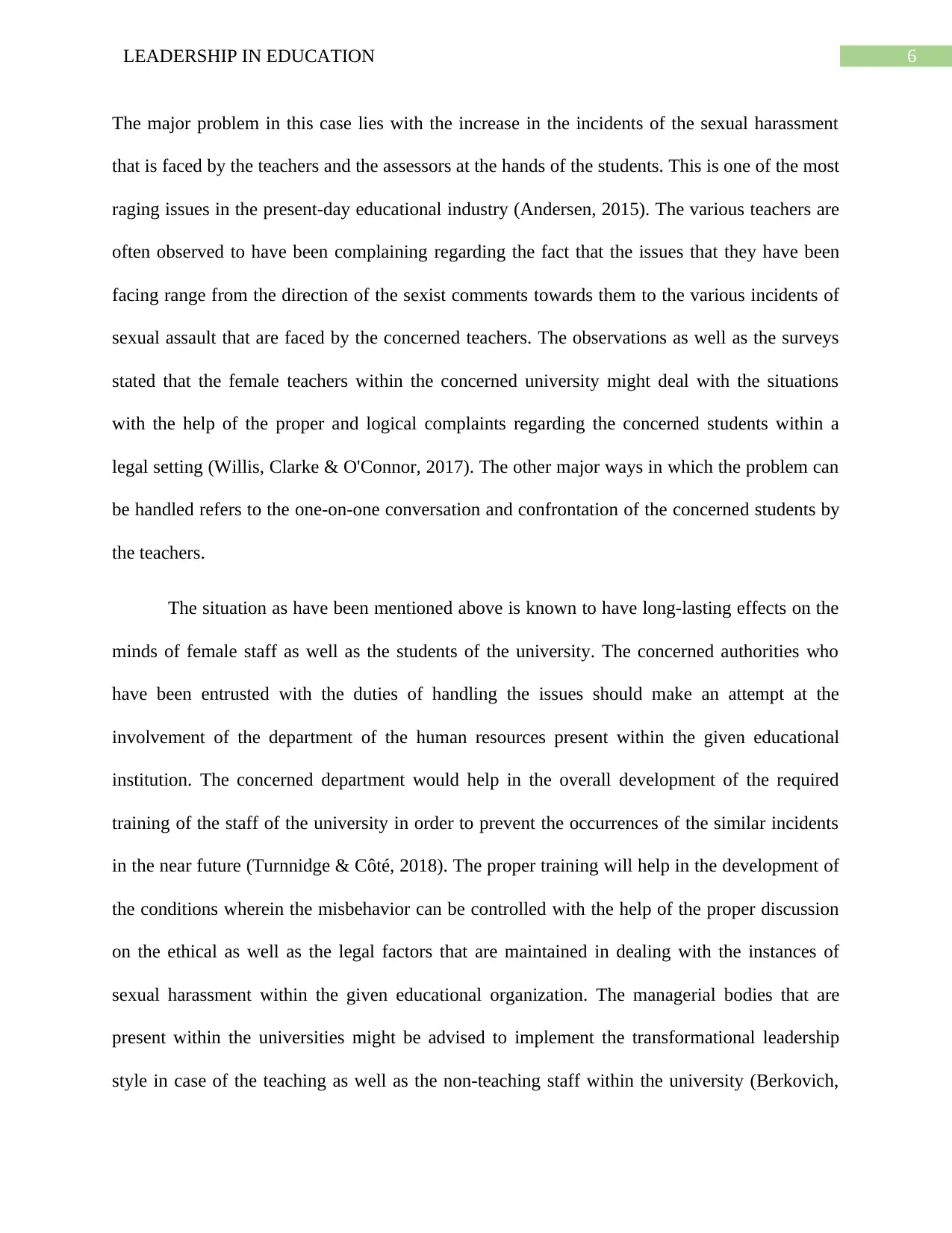
6LEADERSHIP IN EDUCATION
The major problem in this case lies with the increase in the incidents of the sexual harassment
that is faced by the teachers and the assessors at the hands of the students. This is one of the most
raging issues in the present-day educational industry (Andersen, 2015). The various teachers are
often observed to have been complaining regarding the fact that the issues that they have been
facing range from the direction of the sexist comments towards them to the various incidents of
sexual assault that are faced by the concerned teachers. The observations as well as the surveys
stated that the female teachers within the concerned university might deal with the situations
with the help of the proper and logical complaints regarding the concerned students within a
legal setting (Willis, Clarke & O'Connor, 2017). The other major ways in which the problem can
be handled refers to the one-on-one conversation and confrontation of the concerned students by
the teachers.
The situation as have been mentioned above is known to have long-lasting effects on the
minds of female staff as well as the students of the university. The concerned authorities who
have been entrusted with the duties of handling the issues should make an attempt at the
involvement of the department of the human resources present within the given educational
institution. The concerned department would help in the overall development of the required
training of the staff of the university in order to prevent the occurrences of the similar incidents
in the near future (Turnnidge & Côté, 2018). The proper training will help in the development of
the conditions wherein the misbehavior can be controlled with the help of the proper discussion
on the ethical as well as the legal factors that are maintained in dealing with the instances of
sexual harassment within the given educational organization. The managerial bodies that are
present within the universities might be advised to implement the transformational leadership
style in case of the teaching as well as the non-teaching staff within the university (Berkovich,
The major problem in this case lies with the increase in the incidents of the sexual harassment
that is faced by the teachers and the assessors at the hands of the students. This is one of the most
raging issues in the present-day educational industry (Andersen, 2015). The various teachers are
often observed to have been complaining regarding the fact that the issues that they have been
facing range from the direction of the sexist comments towards them to the various incidents of
sexual assault that are faced by the concerned teachers. The observations as well as the surveys
stated that the female teachers within the concerned university might deal with the situations
with the help of the proper and logical complaints regarding the concerned students within a
legal setting (Willis, Clarke & O'Connor, 2017). The other major ways in which the problem can
be handled refers to the one-on-one conversation and confrontation of the concerned students by
the teachers.
The situation as have been mentioned above is known to have long-lasting effects on the
minds of female staff as well as the students of the university. The concerned authorities who
have been entrusted with the duties of handling the issues should make an attempt at the
involvement of the department of the human resources present within the given educational
institution. The concerned department would help in the overall development of the required
training of the staff of the university in order to prevent the occurrences of the similar incidents
in the near future (Turnnidge & Côté, 2018). The proper training will help in the development of
the conditions wherein the misbehavior can be controlled with the help of the proper discussion
on the ethical as well as the legal factors that are maintained in dealing with the instances of
sexual harassment within the given educational organization. The managerial bodies that are
present within the universities might be advised to implement the transformational leadership
style in case of the teaching as well as the non-teaching staff within the university (Berkovich,
Paraphrase This Document
Need a fresh take? Get an instant paraphrase of this document with our AI Paraphraser
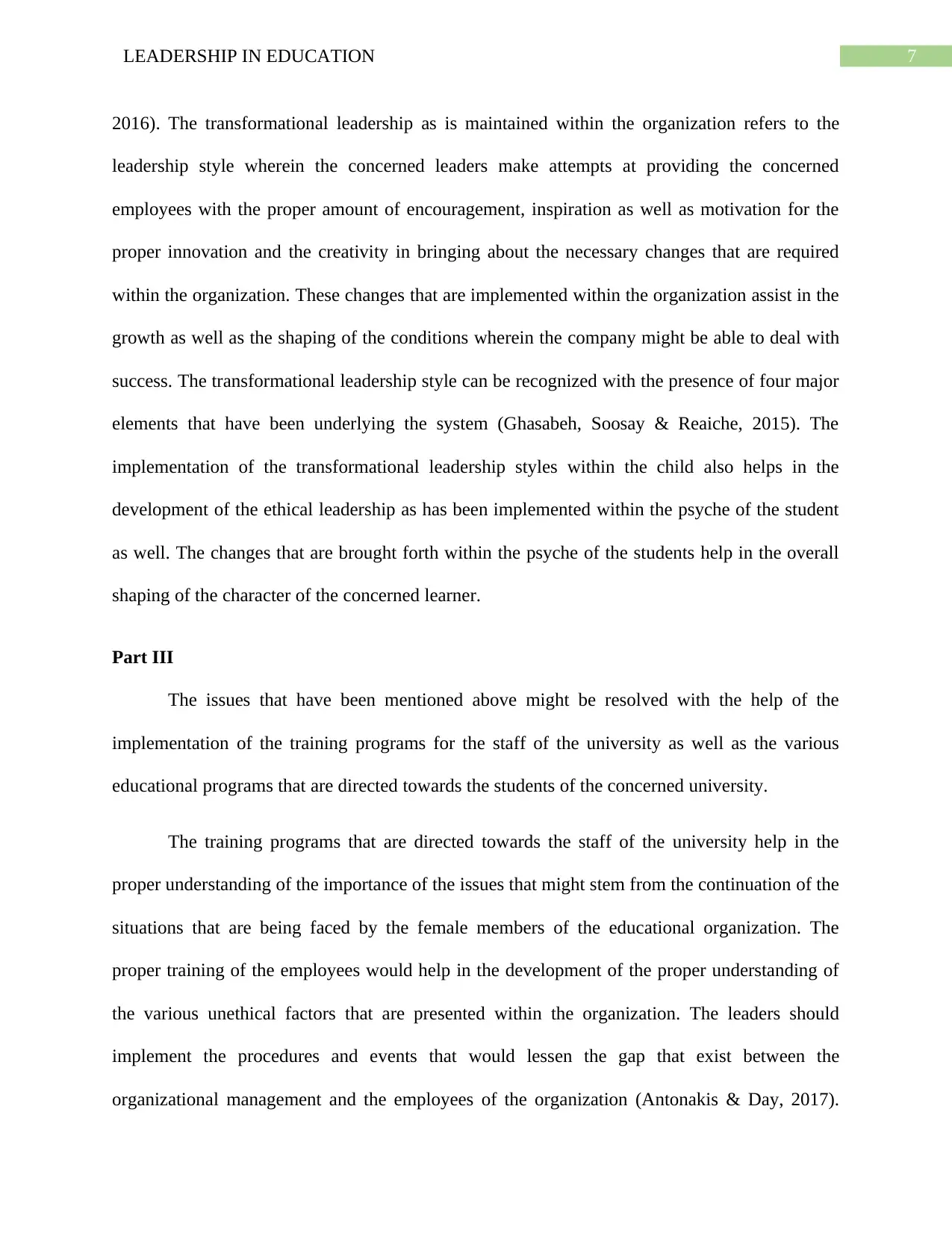
7LEADERSHIP IN EDUCATION
2016). The transformational leadership as is maintained within the organization refers to the
leadership style wherein the concerned leaders make attempts at providing the concerned
employees with the proper amount of encouragement, inspiration as well as motivation for the
proper innovation and the creativity in bringing about the necessary changes that are required
within the organization. These changes that are implemented within the organization assist in the
growth as well as the shaping of the conditions wherein the company might be able to deal with
success. The transformational leadership style can be recognized with the presence of four major
elements that have been underlying the system (Ghasabeh, Soosay & Reaiche, 2015). The
implementation of the transformational leadership styles within the child also helps in the
development of the ethical leadership as has been implemented within the psyche of the student
as well. The changes that are brought forth within the psyche of the students help in the overall
shaping of the character of the concerned learner.
Part III
The issues that have been mentioned above might be resolved with the help of the
implementation of the training programs for the staff of the university as well as the various
educational programs that are directed towards the students of the concerned university.
The training programs that are directed towards the staff of the university help in the
proper understanding of the importance of the issues that might stem from the continuation of the
situations that are being faced by the female members of the educational organization. The
proper training of the employees would help in the development of the proper understanding of
the various unethical factors that are presented within the organization. The leaders should
implement the procedures and events that would lessen the gap that exist between the
organizational management and the employees of the organization (Antonakis & Day, 2017).
2016). The transformational leadership as is maintained within the organization refers to the
leadership style wherein the concerned leaders make attempts at providing the concerned
employees with the proper amount of encouragement, inspiration as well as motivation for the
proper innovation and the creativity in bringing about the necessary changes that are required
within the organization. These changes that are implemented within the organization assist in the
growth as well as the shaping of the conditions wherein the company might be able to deal with
success. The transformational leadership style can be recognized with the presence of four major
elements that have been underlying the system (Ghasabeh, Soosay & Reaiche, 2015). The
implementation of the transformational leadership styles within the child also helps in the
development of the ethical leadership as has been implemented within the psyche of the student
as well. The changes that are brought forth within the psyche of the students help in the overall
shaping of the character of the concerned learner.
Part III
The issues that have been mentioned above might be resolved with the help of the
implementation of the training programs for the staff of the university as well as the various
educational programs that are directed towards the students of the concerned university.
The training programs that are directed towards the staff of the university help in the
proper understanding of the importance of the issues that might stem from the continuation of the
situations that are being faced by the female members of the educational organization. The
proper training of the employees would help in the development of the proper understanding of
the various unethical factors that are presented within the organization. The leaders should
implement the procedures and events that would lessen the gap that exist between the
organizational management and the employees of the organization (Antonakis & Day, 2017).

8LEADERSHIP IN EDUCATION
The leaders should aim at inspiring and empathizing with the employees of the organization in
order to help them understand and adopt to the visions that are set by the organization. This in
turn would help in the overall development of the tendencies of the concerned followers to make
sacrifices that would in turn greater good in the longer run (Banks et al., 2016). This would help
in instilling within the staff a vision as well as a mission that would inspire the followers to
develop an identity of their own and thereby help in lowering of the sexual harassment that is
faced by the female faculty.
The concerned authorities within the university administration might be advised to
introduce the courses that help the students in the understanding of the unethical nature of the
sexual harassment of the female faculty within the educational institution (Page & Pina, 2015).
The major problem in this case lies with the increase in the incidents of the sexual harassment
that is faced by the teachers and the assessors at the hands of the students. The observations as
well as the surveys stated that the female teachers within the concerned university might deal
with the situations with the help of the proper and logical complaints regarding the concerned
students within a legal setting. The other major ways in which the problem can be handled refers
to the one-on-one conversation and confrontation of the concerned students by the teachers
(Valls et al., 2016). The proper training will help in the development of the conditions wherein
the misbehavior can be controlled with the help of the proper discussion on the ethical as well as
the legal factors that are maintained in dealing with the instances of sexual harassment within the
given educational organization (Quick & McFadyen, 2017). The educators, teachers and the
mentors are observed to have been dealing with the responsibilities of educating and shaping the
future of a child. The educators are required to fulfil the roles of the leaders and the role models
for the students.
The leaders should aim at inspiring and empathizing with the employees of the organization in
order to help them understand and adopt to the visions that are set by the organization. This in
turn would help in the overall development of the tendencies of the concerned followers to make
sacrifices that would in turn greater good in the longer run (Banks et al., 2016). This would help
in instilling within the staff a vision as well as a mission that would inspire the followers to
develop an identity of their own and thereby help in lowering of the sexual harassment that is
faced by the female faculty.
The concerned authorities within the university administration might be advised to
introduce the courses that help the students in the understanding of the unethical nature of the
sexual harassment of the female faculty within the educational institution (Page & Pina, 2015).
The major problem in this case lies with the increase in the incidents of the sexual harassment
that is faced by the teachers and the assessors at the hands of the students. The observations as
well as the surveys stated that the female teachers within the concerned university might deal
with the situations with the help of the proper and logical complaints regarding the concerned
students within a legal setting. The other major ways in which the problem can be handled refers
to the one-on-one conversation and confrontation of the concerned students by the teachers
(Valls et al., 2016). The proper training will help in the development of the conditions wherein
the misbehavior can be controlled with the help of the proper discussion on the ethical as well as
the legal factors that are maintained in dealing with the instances of sexual harassment within the
given educational organization (Quick & McFadyen, 2017). The educators, teachers and the
mentors are observed to have been dealing with the responsibilities of educating and shaping the
future of a child. The educators are required to fulfil the roles of the leaders and the role models
for the students.
⊘ This is a preview!⊘
Do you want full access?
Subscribe today to unlock all pages.

Trusted by 1+ million students worldwide

9LEADERSHIP IN EDUCATION
Conclusion
The above discussion might be concluded on the lines that state that the leadership
qualities are useful in the resolution of the issues that are faced by the university in discussion.
These measures would help in the overall development of the psyche of the students which in
turn would help in the proper understanding of the ill-effects of the sexual harassment of the
female staff of the universities.
Conclusion
The above discussion might be concluded on the lines that state that the leadership
qualities are useful in the resolution of the issues that are faced by the university in discussion.
These measures would help in the overall development of the psyche of the students which in
turn would help in the proper understanding of the ill-effects of the sexual harassment of the
female staff of the universities.
Paraphrase This Document
Need a fresh take? Get an instant paraphrase of this document with our AI Paraphraser
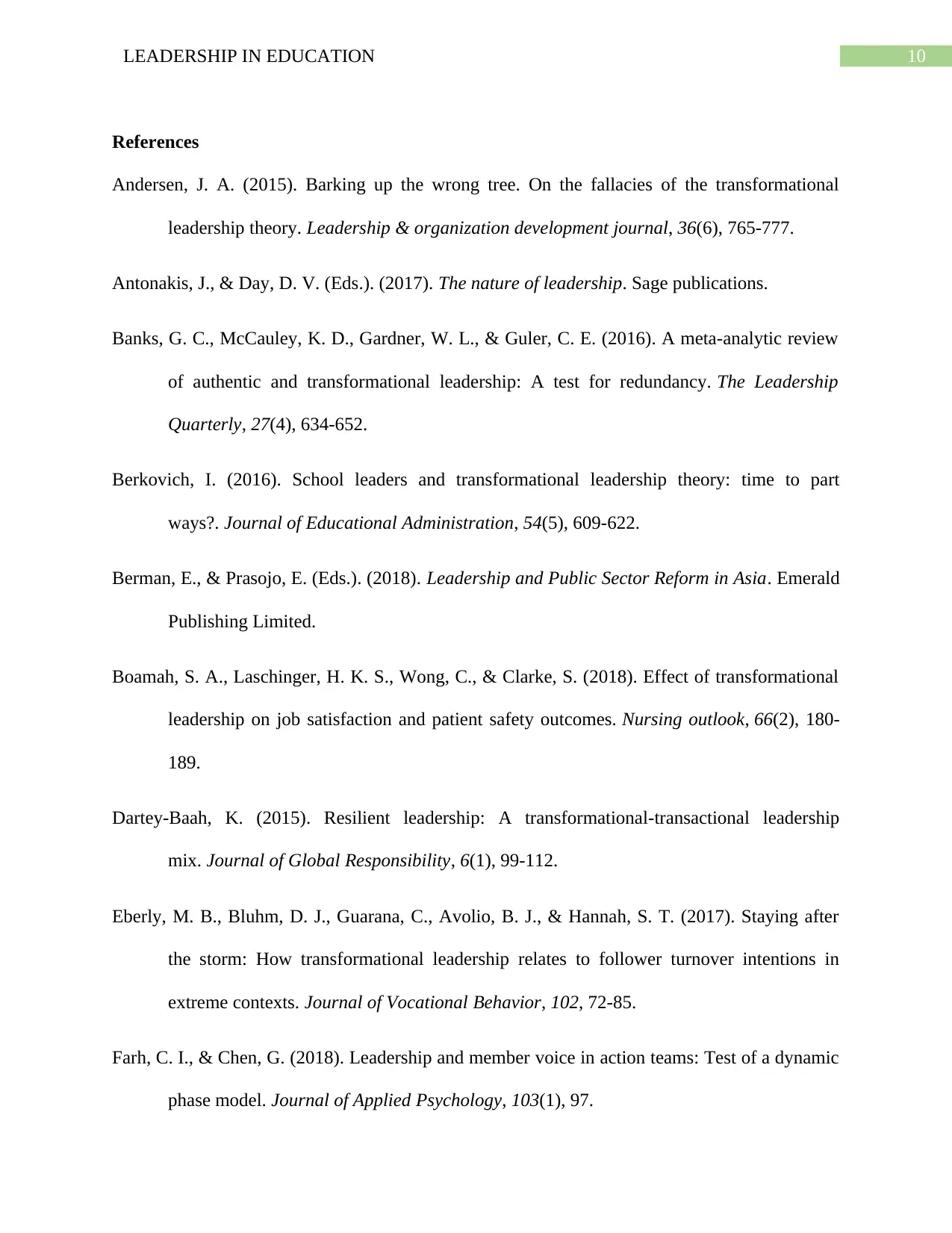
10LEADERSHIP IN EDUCATION
References
Andersen, J. A. (2015). Barking up the wrong tree. On the fallacies of the transformational
leadership theory. Leadership & organization development journal, 36(6), 765-777.
Antonakis, J., & Day, D. V. (Eds.). (2017). The nature of leadership. Sage publications.
Banks, G. C., McCauley, K. D., Gardner, W. L., & Guler, C. E. (2016). A meta-analytic review
of authentic and transformational leadership: A test for redundancy. The Leadership
Quarterly, 27(4), 634-652.
Berkovich, I. (2016). School leaders and transformational leadership theory: time to part
ways?. Journal of Educational Administration, 54(5), 609-622.
Berman, E., & Prasojo, E. (Eds.). (2018). Leadership and Public Sector Reform in Asia. Emerald
Publishing Limited.
Boamah, S. A., Laschinger, H. K. S., Wong, C., & Clarke, S. (2018). Effect of transformational
leadership on job satisfaction and patient safety outcomes. Nursing outlook, 66(2), 180-
189.
Dartey-Baah, K. (2015). Resilient leadership: A transformational-transactional leadership
mix. Journal of Global Responsibility, 6(1), 99-112.
Eberly, M. B., Bluhm, D. J., Guarana, C., Avolio, B. J., & Hannah, S. T. (2017). Staying after
the storm: How transformational leadership relates to follower turnover intentions in
extreme contexts. Journal of Vocational Behavior, 102, 72-85.
Farh, C. I., & Chen, G. (2018). Leadership and member voice in action teams: Test of a dynamic
phase model. Journal of Applied Psychology, 103(1), 97.
References
Andersen, J. A. (2015). Barking up the wrong tree. On the fallacies of the transformational
leadership theory. Leadership & organization development journal, 36(6), 765-777.
Antonakis, J., & Day, D. V. (Eds.). (2017). The nature of leadership. Sage publications.
Banks, G. C., McCauley, K. D., Gardner, W. L., & Guler, C. E. (2016). A meta-analytic review
of authentic and transformational leadership: A test for redundancy. The Leadership
Quarterly, 27(4), 634-652.
Berkovich, I. (2016). School leaders and transformational leadership theory: time to part
ways?. Journal of Educational Administration, 54(5), 609-622.
Berman, E., & Prasojo, E. (Eds.). (2018). Leadership and Public Sector Reform in Asia. Emerald
Publishing Limited.
Boamah, S. A., Laschinger, H. K. S., Wong, C., & Clarke, S. (2018). Effect of transformational
leadership on job satisfaction and patient safety outcomes. Nursing outlook, 66(2), 180-
189.
Dartey-Baah, K. (2015). Resilient leadership: A transformational-transactional leadership
mix. Journal of Global Responsibility, 6(1), 99-112.
Eberly, M. B., Bluhm, D. J., Guarana, C., Avolio, B. J., & Hannah, S. T. (2017). Staying after
the storm: How transformational leadership relates to follower turnover intentions in
extreme contexts. Journal of Vocational Behavior, 102, 72-85.
Farh, C. I., & Chen, G. (2018). Leadership and member voice in action teams: Test of a dynamic
phase model. Journal of Applied Psychology, 103(1), 97.
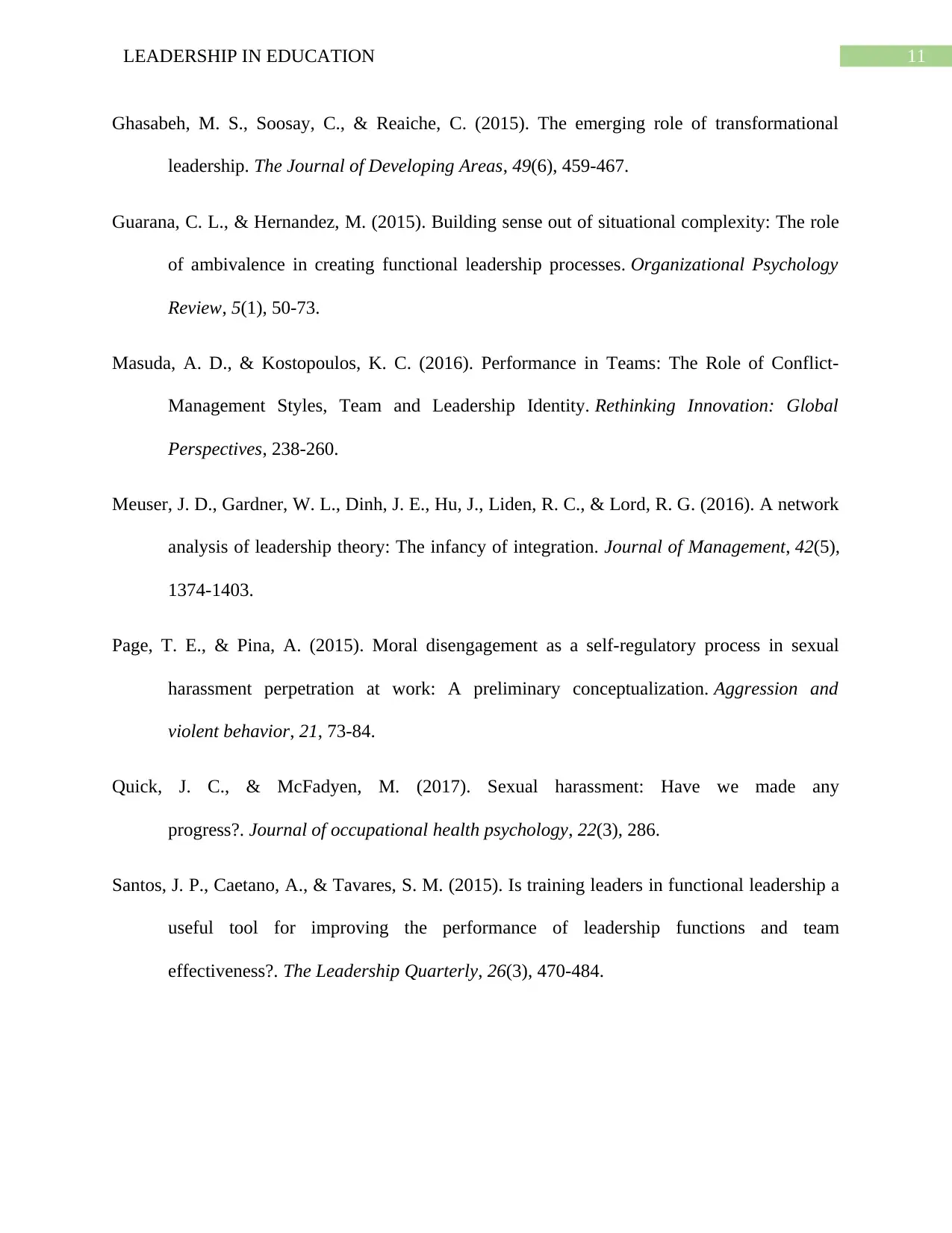
11LEADERSHIP IN EDUCATION
Ghasabeh, M. S., Soosay, C., & Reaiche, C. (2015). The emerging role of transformational
leadership. The Journal of Developing Areas, 49(6), 459-467.
Guarana, C. L., & Hernandez, M. (2015). Building sense out of situational complexity: The role
of ambivalence in creating functional leadership processes. Organizational Psychology
Review, 5(1), 50-73.
Masuda, A. D., & Kostopoulos, K. C. (2016). Performance in Teams: The Role of Conflict-
Management Styles, Team and Leadership Identity. Rethinking Innovation: Global
Perspectives, 238-260.
Meuser, J. D., Gardner, W. L., Dinh, J. E., Hu, J., Liden, R. C., & Lord, R. G. (2016). A network
analysis of leadership theory: The infancy of integration. Journal of Management, 42(5),
1374-1403.
Page, T. E., & Pina, A. (2015). Moral disengagement as a self-regulatory process in sexual
harassment perpetration at work: A preliminary conceptualization. Aggression and
violent behavior, 21, 73-84.
Quick, J. C., & McFadyen, M. (2017). Sexual harassment: Have we made any
progress?. Journal of occupational health psychology, 22(3), 286.
Santos, J. P., Caetano, A., & Tavares, S. M. (2015). Is training leaders in functional leadership a
useful tool for improving the performance of leadership functions and team
effectiveness?. The Leadership Quarterly, 26(3), 470-484.
Ghasabeh, M. S., Soosay, C., & Reaiche, C. (2015). The emerging role of transformational
leadership. The Journal of Developing Areas, 49(6), 459-467.
Guarana, C. L., & Hernandez, M. (2015). Building sense out of situational complexity: The role
of ambivalence in creating functional leadership processes. Organizational Psychology
Review, 5(1), 50-73.
Masuda, A. D., & Kostopoulos, K. C. (2016). Performance in Teams: The Role of Conflict-
Management Styles, Team and Leadership Identity. Rethinking Innovation: Global
Perspectives, 238-260.
Meuser, J. D., Gardner, W. L., Dinh, J. E., Hu, J., Liden, R. C., & Lord, R. G. (2016). A network
analysis of leadership theory: The infancy of integration. Journal of Management, 42(5),
1374-1403.
Page, T. E., & Pina, A. (2015). Moral disengagement as a self-regulatory process in sexual
harassment perpetration at work: A preliminary conceptualization. Aggression and
violent behavior, 21, 73-84.
Quick, J. C., & McFadyen, M. (2017). Sexual harassment: Have we made any
progress?. Journal of occupational health psychology, 22(3), 286.
Santos, J. P., Caetano, A., & Tavares, S. M. (2015). Is training leaders in functional leadership a
useful tool for improving the performance of leadership functions and team
effectiveness?. The Leadership Quarterly, 26(3), 470-484.
⊘ This is a preview!⊘
Do you want full access?
Subscribe today to unlock all pages.

Trusted by 1+ million students worldwide
1 out of 13
Related Documents
Your All-in-One AI-Powered Toolkit for Academic Success.
+13062052269
info@desklib.com
Available 24*7 on WhatsApp / Email
![[object Object]](/_next/static/media/star-bottom.7253800d.svg)
Unlock your academic potential
Copyright © 2020–2025 A2Z Services. All Rights Reserved. Developed and managed by ZUCOL.





